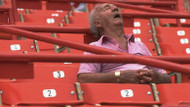If all goes according to plan, the next Major League Baseball game you attend will move along at a slightly faster clip than the last game you went to.
Here are a few ways that could impact you:
No one's a fan of waiting.
Do you think the complaints are legitimate? First, answer these questions honestly:
Shouldn’t a baseball fan, even a real baseball fan, be able to say the game is slow and ask for a better performance?
No clock, no rush.
The simple fact is, because there is no clock in baseball, there’s no real urgency to keep the game moving at a fast clip. (Basketball has a shot clock; football has a delay-of-game penalty.) Batters step in and out of the box between each pitch and do all kinds of crazy rituals (think David Ortiz). Pitchers step off the mound and roam around and don’t step on the rubber until they’re good and ready…and then they get the catcher’s signal (think Jonathan Papelbon).
Fans today want action, not inaction. We don’t go to games to hear the batters’ walk-up songs and watch them fiddle around. Or do we?
Whose idea was this anyway?
Major League Baseball heard the complaints and created a special “Pace of Game” committee to consider and recommend changes. Out of a handful of recommendations, a few new rules emerged…with the approval of the Players Association. New MLB Commissioner Rob Manfred says the rules will “help speed up a basic action of the game.”
The new rules.
Here are the three main pace-of-game rule changes that will be in effect when your home team takes the field in 2015:
Batters must keep a foot in the batter’s box. This new rule is intended to stop the annoying habit so many hitters have developed—taking a pitch, stepping out of the box, adjusting their gloves…and then making other routine maneuvers before stepping back in the box. Now batters have to be ready to hit.
There are logical exceptions to the rule: A batter is allowed to be out of the box after a wild pitch or passed ball, and he can still request a time-out from the umpire. But if the batter takes his sweet time getting back in the box, the umpire can call an automatic strike. Also, the batter can be fined when he breaks the rule.
Pitchers and hitters are on the clock at the start of half-innings. Fans rarely think about the time between half-innings. That’s because it gives everyone a chance to run to the concession stand or the restroom. But MLB is cracking down on long commercial breaks that delay the start of each half-inning.
They’re doing it by putting a time clock on the commercials between half-innings, and in the process, they’re putting the pitcher, batter and even the guy who plays the hitter’s walk-up song on the clock. The goal? To force the pitcher and batter to be ready once the commercial break ends.
Here’s how it’s going to work:
Manager’s can challenge from the dugout. There’s also a new rule that allows managers to challenge a call without going onto the field. That will prevent the current practice where managers kill time while an assistant coach gets the word from upstairs on whether to challenge the call.
What are some hitters saying?
Carlos Beltran of the Yankees says he’s in favor of the rules, but he knows not everyone will be. “Once I’m [in the batter’s box], I want to hit,” Beltran says. “I want to do my job; but other players normally take their time, come out and do certain things in order for them to feel comfortable. It probably will hurt some other hitters.”
One of those hitters is an unhappy David Ortiz of the Boston Red Sox. “It seems like every rule goes in the pitcher’s favor,” Ortiz griped, adding that making the batter stay in the box puts him at a disadvantage. “When you force a hitter to do that…you are out, because you don’t have that time to think.” About the fine for breaking the rule, he says, “I’m not going to change my game…I might run out of money.”
MLB said there would be no fines issued in Spring Training or the first month of the 2015 season as players adjust to the rules. But starting in May, when the umpire yells, “Play ball!” he’ll mean it.
